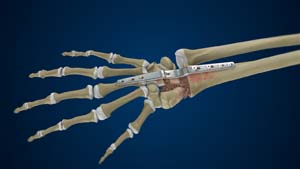
Wrist Anatomy
The wrist joint is one of the most complex joints in the human body. Numerous joints and bones contribute to the strength and stability of the wrist. The wrist is made up of eight separate small bones called carpal bones. The carpal bones connect the two bones of the forearm, the radius and the ulna, to the bones of the hand. The metacarpal bones are the long bones that lie within the palm and attach to the phalanges, the bones in the fingers and thumb.
What is Arthritis?
Articular cartilage is the white tissue lining the ends of bones where the bones connect to form joints. The cartilage acts as cushioning material and helps in smooth gliding of the bones during movement. An injury to the joint may damage this cartilage, causing severe pain and inflammation, known as degenerative arthritis.
What is Total Wrist Arthrodesis?
Arthrodesis is the surgical immobilization of a joint by the fusion of the adjacent bones.
Total wrist arthrodesis, also known as wrist fusion, is a surgical procedure in which the wrist joint is stabilized or immobilized by fusing the forearm bone (radius) with the small bones of the wrist.
Indications of Total Wrist Arthrodesis
A painful wrist causes disability and affects function of the upper extremity. Arthrodesis is commonly performed to relieve pain from arthritis or after severe trauma to the wrist.
Total wrist arthrodesis may be recommended by your doctor when conservative treatments such as rest, medications, injections and physical therapy do not relieve the pain. Indications for the surgery include:
- Advanced symptomatic arthritis secondary to a degenerative, post-traumatic, inflammatory or post-infectious condition
- Wrist trauma and instability
- Joint destruction due to tumors
- Correction of wrist deformities in patients with spastic hemiplegia
- Unsuccessful wrist reconstruction or arthroplasty with or without joint replacement
Total Wrist Arthrodesis Procedure
Various techniques are used for achieving a successful arthrodesis. The type of operative technique depends on the underlying condition, quality of bone, condition of the remaining joints of the involved extremity, and the surgeon’s preference.
Total wrist arthrodesis is usually performed under general anesthesia. Your surgeon makes an incision on the back of the wrist. The soft tissues are retracted to gain access to the bones and joints of the wrist. Any articular cartilage present is removed from each joint to be fused and a bone graft (typically derived from the end of the radius bone) is used to replace the lost cartilage.
A metal plate with screw holes is placed over the back of the wrist. The plate extends from the radius to the metacarpal bone of the middle finger and is attached to the bone with metal screws. The plate holds the bones in the proper position and ensures that they stay together during the healing process. The plate remains in the body and is not removed unless it is causing problems. At the end of the procedure, the incisions are closed with sutures, and a sterile dressing and splint is applied.
Postoperative Care following Total Wrist Arthrodesis
The post-surgical instructions to follow depend on the type of repair performed.
Some of the instructions include:
- Take medications as prescribed by your doctor to help alleviate pain and make you comfortable.
- Keep your arm elevated on pillows above the level of the heart; it is the most important thing you can do to reduce swelling.
- Keep the incision area clean and dry. If the wrist is enclosed by a splint, cover the splint with plastic bags and tape it to your skin above the slint to keep it dry when bathing.
- Follow the suggested instructions regarding activity and rehabilitation.
- Physical therapy may be ordered to help restore wrist function, strength and finger range of motion.
- Eating a healthy diet and not smoking promotes healing.
Risks and Complications of Total Wrist Arthrodesis
As with any major surgery, there are potential risks involved with total wrist arthrodesis. Complications can occur following total wrist arthrodesis and include:
- Infection
- Excess bleeding
- Damage to blood vessels
- Nerve injury
- Problems with instrumentation
- Failure of bone fusion (non-union)
Related Topics
- Osteotomy for Distal Radius Malunion
- Wrist Open Reduction and Internal Fixation
- ORIF of Distal Radius Fracture
- Trapeziectomy
- Peripheral Nerve Repair
- Wrist Arthroscopy
- Microvascular Surgery
- Wrist Joint Replacement
- Carpal Tunnel Release Surgery
- Wrist Ligament Reconstruction
- Total Wrist Arthrodesis
- Hand Fracture Surgery
- ORIF of the Forearm Fractures
- Endoscopic Carpal Tunnel Surgery
- Wrist Fracture Fixation
- Sports Injury Management of Hand, Wrist and Elbow





